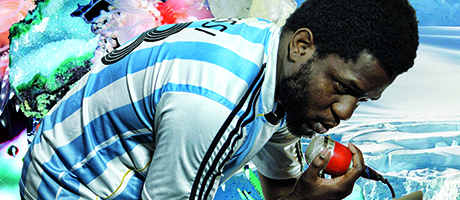The Norient organisation is set to publish a new book, Seismographic Sounds: Visions Of A New World, soon. The volume collects essays and interviews by writers in more than 50 countries discussing music scenes and movements below the radar of mainstream media. The topics covered range from Ukranian noise to Syrian metal.
The Norient organisation, based in Switzerland, is a publisher, promoter, festival organiser and online platform dedicated to seeking out new sounds across the world, and Seismographic Sounds focuses especially on the new spaces and possibilities opened up by the internet. The collection is edited by Theresa Beyer, Thomas Burkhalter and Hannes Liechti, and can be ordered direct from the Norient website. The book will be complemented by a Seismographic Soundsexhibition at the ZKM gallery in Karlsruhe, Germany in October, and at Berlin’s Transmediale festival next February.
INTRODUCTION
Seismographic Sounds – Visions of a New World introduces you to a contemporary world of distinct music, sounds and music videos. Two hundred and fifty scholars, journalists, bloggers and musicians from Bolivia, Pakistan, Nigeria, Switzerland and forty-six other countries present and discuss artistic expressions that may not make big headlines yet, but anticipate major changes to come in our time. Produced in oftentimes small studios from Jakarta to La Paz, Cape Town to Helsinki, these works experiment with the new possibilities of the Internet age and illuminate new spaces beyond the confines of commercialism, propaganda, fanatism, racism, sexism and homophobia. They foresee a changing geography of multi-layered modernities, far beyond old ideas of North versus South, East versus West.
Musicians and video artists presented in this book create their home countries anew: through focusing on international niche genres, parodies on exotica, post-digital visions, random sampling of data streams, or working with music and sounds that have for too long fallen outside elitist cultural canons. Cheap software and production costs, the possibilities to connect through social media and spread music and videos online, or digital access to an overwhelming amount of data and knowledge are some of the engines behind this cultural revolution. If music is a window into the future—as scholars and composers have been arguing for a long time—then we know: these new positions will change our perception of music and the world very soon. «Gangnam Style» by South Korean rapper Psy, baile funk, kuduro and mahragan, for example, are only first steps. Future mainstream hits and underground trends will come from Africa, Asia and Latin America too, produced and financed locally, without the support of Euro-American agents. The predicted economic shift towards Asia and possibly Africa has already started to manifest itself in music. While a seismograph measures and records force and duration of earthquakes, we, with this book, aim to closely measure these visions of a new world.
Contemporary Music and Video Clips Seismographic Sounds—the book and the exhibition project—is the result of twelve years of work with Norient, of traveling to places like Karachi, Beirut, Cairo or Accra for reportages and documentaries, of networking with scholars, music journalists, bloggers and—last but not least—musicians and video artists. From them we keep learning: contemporary expressions are rich fields of experimentation; judging is delicate; much is unfinished, not fixed but in flux, quickly switching between peaks and lows. Or: music is changing on all levels—in its production, financing, promotion, distribution, and even in its shapes and formats. Music videos, for instance, became an important tool for upcoming artists to playfully challenge the interplay between sound and image, and to come forward with new representations of the world around us. Through music videos niche music reaches an increased amount of viewers and gains cultural, social and political impact. This is why one focus of Seismographic Sounds falls on music videos and its main platform, YouTube, while we also present music and musicians that we value and have been following for several years.
In 2013 we started to ask musicians, DJs, journalists, bloggers and scholars from our Norient network to send us their five favorite current music clips from their respective countries. We received two thousand clips from which we selected what we found to be the six most present and pressing topics: Money, a concern for capitalism and corruption; Loneliness, with videos that picture lonely individuals in anti-social societies; War, how war remains a fascinating audiovisual topic—while never since World War Two have so many people been forced to flee from war and violence; Exotica, dealing with new and old renderings of cultural stereotypes; Desire, engaging with new gender roles and queer identities; and Belonging, dedicated to artistic representations of place and new post-digital visions. The tags at the bottom of the pages of the book indicate that each topic is re-worked by musicians from different angles and positions. Tags like «DIY» or «protest» invite the reader to skim through this book in alternative ways. Augmented Empiricism To work in collaboration with many writers is fundamental to our methodological and theoretical approach.
Today more music is being produced than ever before and the search for new sounds, aesthetics, cultural forms and political positions is almost endless. A short search on the music platform SoundCloud leaves one with frustration: how to keep up with all these latest tracks? The RSS feed, through which we at Norient follow around one hundred music blogs and sites, is replete with unread posts and articles. Meanwhile, journals of ethnomusicology, popular music studies or sound studies offer a great amount of well-researched academic articles annually. The quantities are absurd. Ethnomusicologist Wendy Hsu (2014) speaks of an «augmented empiricism.» The task is to keep conducting ethnographic fieldwork, but also to transform «big data» (from online platforms) into what Tricia Wang (2013) calls «thick data,» deduced from the concept of «thick description» formulated by Clifford Geertz. «Thick data» is then a means for incorporating many tracks and artists into an analysis of today: how were they produced, who listens to them, what do they stand for, how are they connected to local and transnational trends? These and many other questions we three Europeans from Norient cannot research and answer alone. Consequently, we invited academics, journalists, musicians, bloggers, photographers and graphic designers from fifty countries to comment on twenty-four selected music clips (two writers for each clip), to offer short personal statements, to write about recent trends, to impart experiences in ethnographic fieldwork, and to present overviews about academic key concepts of music research.
We thank you all so much for your participation! We further experimented with forms and formats, some not proven by time: What are Skype interviews worth? How do we select and choose who writes for this book and who does not? In some cases we asked musicians: who is in your opinion the best music journalist in your country? How severely can we edit and re-work texts by non-English speakers without changing intended meanings? Does this book need to be in English only, or might a multi-lingual approach—as we propose it—be more fruitful? To work multi-authored and multi-local again has its limits. The final decision of what to include in the book and the exhibition stayed with us—except in quite a few cases in the UK, where managers and artists did not reply or did not want to be part of this project and thereby decided for us (while many others immediately loved the idea and gave us the right to work with their clips, for example the management of Belgian superstar Stromae). But more importantly: Can our approach become even more multi-local in the future? How can we achieve that? The book is called Seismographic Sounds – Visions of a New World because it measures the current developments described above. And because visions are often fragile—in this case coproduced between musicians and video artists, cultural agents, multipliers and academics around the globe. We too—like the musicians—worked to exhaustion, doing everything ourselves, from conception, funding, coordination, writing, editing, promoting and selling, being overwhelmed by the number of emails and phone calls, and the complexity of tasks. For the musicians, to have fast Internet, to speak English, to live in a country with freedom of speech, to own a credit card, are major advantages if they compete online.
These musicians often lack support and take many risks—some were even killed and others received death threats for expressing themselves. Overall, these tracks, songs, compositions and music clips express what is thinkable and doable. They are direct, urgent, passionate, strong and yet fragile visions of a new world. We hope that this mosaic of texts and images offers the reader insights and a feeling of what are main topics, concepts, debates and challenges at play. Our goal is not to create a big theory that is void of examples (or built on old examples), but rather we try—through working with a large amount of contemporary examples—hopefully to contribute to a theory of today. This book and the exhibition are a passionate step towards an approach that we intend to continue with our online magazine Norient.com, the Norient Musikfilm Festival and other multi-disciplinary projects. We believe that when the passion, talent and energy of artists, scholars and journalists come together, descriptions of music and the world become richer, more diverse, and at times more challenging.
Thomas Burkhalter, July 2015 ✪




